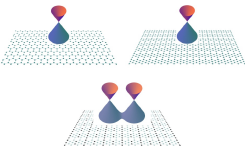Dirac Fermions in Borophene
I. Matsuda, Sugino, and Komori Groups
Boron, the fifth element in the periodic table, has been known to be the lightest element substance that forms interatomic covalent bonds. Since the bonding states in the bulk boron ranges from two-center to multi-center bonds, boron forms varieties of allotropes that show rich physical and chemical properties. Up to now, all the allotropes of boron have been found to be semiconducting with a large band gap. Recently, the discovery of graphene has triggered great interest in the search for elemental monolayer materials and theoretical investigations have found existence of the monolayer boron, borophene, that shows metallicity.

Fig. 1. (Upper)Dirac cones in the honeycomb lattice (graphene) and in the β12-sheet structure (borophene). (Lower) A pair of Dirac cones in the periodically modulatedβ12-sheet structure (borophene on Ag(111)).
In the present research, we synthesized a borophene by directly evaporating pure boron (99.9999%) onto a clean Ag(111) substrate. We apparently observed metallic boron-derived band by angle-resolved photoemission spectroscopy (ARPES). There are three pockets of the Fermi surfaces that are supported by the first-principles calculations [1]. Focusing onto a pair of the pockets, we discovered that the band is actually forming a pair of Dirac cones by the high-resolution ARPES measurement using synchrotron radiation [2]. The borophene on Ag(111) forms theβ12-sheet structure and the theoretical calculations, the first principles and the tight-biding models, confirm presence of the Dirac cones. Moreover, by imposing the one-dimensional periodic potentials, the Dirac cones were found to form a pair, which completely reproduce the experimental bands. It is of note that the additional periodicity was confirmed by scanning tunneling microscope on the borophene. These results open the door to designing novel Dirac materials of the non-honeycomb structure and to make additional modification by the substrate that lead to varieties of functionalities (Fig. 1).
References
- [1] B. Feng, J. Zhang, Ro-Ya Liu, T. Iimori, C. Lian, H. Li, L. Chen, K. Wu, S. Meng, F. Komori, and I. Matsuda, Phys. Rev. B 94, 041408(R) (2016).
- [2] B. Feng, O. Sugino, R.-Y. Liu, J. Zhang, R. Yukawa, M. Kawamura, T. Iimori, H. Kim, Y. Hasegawa, H. Li, L. Chen, K. Wu, H. Kumigashira, F. Komori, T.-C. Chiang, S. Meng, and I. Matsuda, Phys. Rev. Lett. 118, 096401 (2017).
